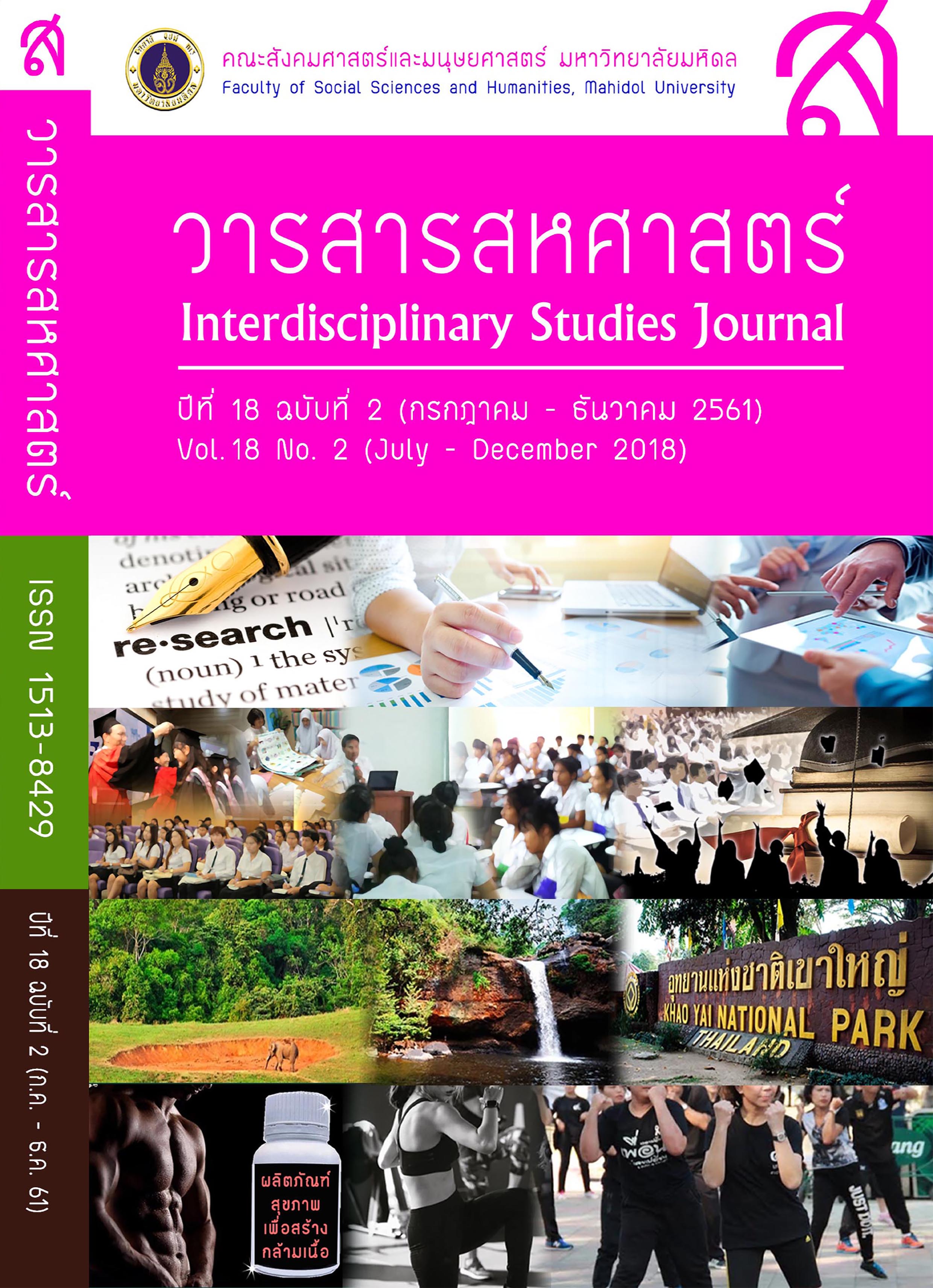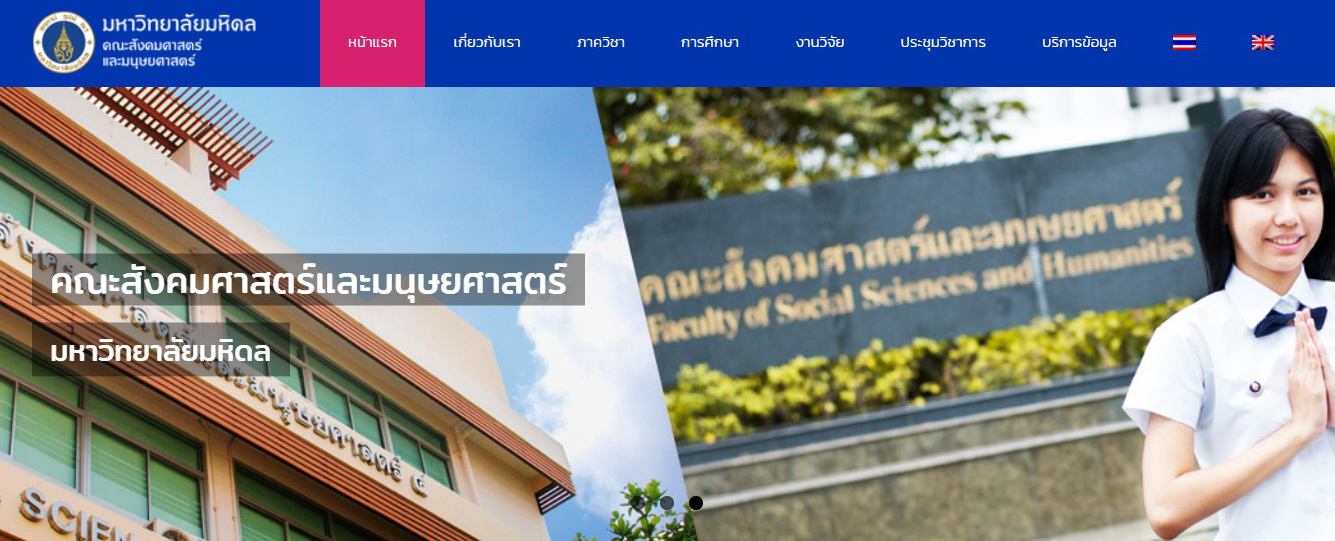“I FEED MY BABY, AS I THINK, IT IS GOOD FOR MY BABY”: BELIEFS AND CULTURAL PRACTICES OF INFANT FEEDING AMONG HIV POSITIVE MOTHERS IN MANDALAY, MYANMAR
บทคัดย่อ
Background: It was estimated that mother to child HIV transmission was 25% on average and there were 304,800 new child HIV infections due to vertical transmission in high HIV prevalent countries in 2010. WHO and medical professionals have recommended Exclusive Breastfeeding (EBF) or Exclusive Formula Feeding/ Exclusive Replacement Feeding (EFF/ERF) for HIV and infant feeding issue considering “HIV free survival” in HIV exposed babies born to HIV positive mothers. Mixed Feeding (MF) with breastfeeding, was strongly associated with increased HIV transmission to the babies while mixed feeding with formula feeding was claimed for increasing infant and under five years old children mortality and morbidity rate. But, infant mixed feeding is still composed of cultural norms, beliefs and practices. This article aimed to explore cultural beliefs and practices of infant mixed feeding practicing HIV positive mothers regarding under six months infant feedings: EFF/ERF, EBF and MF.
Methods: This cross sectional qualitative study applied cultural interpretive medical anthropology. In-depth interviews with HIV positive mothers, peer counselors and medical professionals, focus group discussions with HIV positive mothers, and participant observations on HIV positive mothers’ infant feeding practices were conducted from August 2013 to early January 2014 in Mandalay, Myanmar. The data was entered and analyzed using manual data master sheet.
Findings: Of 29 HIV positive mothers, 25 mothers practiced mixed feeding to their under six months babies. A total of 24 cultural infant mixed feeing patterns were found. The mothers had strong beliefs on cultural good mother and cultural seniority concepts related to infant health, growth and development, and on local infant illnesses: etiology, diagnosis, curative and preventive practices.
Conclusions: Cultural infant mixed feeding practices resulted from HIV positive mothers’ dissatisfied perceptions, disagreement and confusion, of modern medical HIV and infant feeding counseling messages. Those infant mixed feeding patterns were a result of cultural forces of ‘good motherhood’ and ‘cultural seniority’ through ‘lay referral’ practices.
เอกสารอ้างอิง
Baer, H. A., Singer, M. & Susser, I. (2003). Medical Anthropology and the World System (second ed.): Praeger Publishers, 88 Post Road West, Westport, CT 06881. An imprint of Greenwood Publishing Group, Inc. www.praeger.com.
Black, R. E., Allen, L. H., Bhutta, Z. A., Caulfield, L. E., Onis, M. d., Ezzati, M., Mathers, C., & Rivera, J. (2008). Maternal and child undernutrition: global and regional exposures and health consequences. Maternal and Child Undernutrition1: Lancet 2008, 1, 5-22. doi: 10.1016/S0140-6736(07)61690-0
Davies-Adetugbo, Anita A. (1997). Sociocultural factors and the promotion of exclusive breastfeeding in rural Yoruba communities of Osun State, Nigeria. Social Science & Medicine, 45(1), 113-125. doi: https://dx.doi.org/10.1016/S0277-9536(96)00320-6
Desclaux, A., & Alfieri, C. (2010). Facing competing cultures of breastfeeding: the experience of HIV‐positive women in Burkina Faso. Infant feeding beliefs and practices across cultures, Liamputtong P. (ed), 195-210.
Hardon, A., Boonmongkon, P., Streefland, P., Tan, M. L., Hongvivatana, T., Geest, Sjaak V. D., … Gerrits, T. (2001). Applied Health Research Manual: Anthropology Of Health and Health care (Third ed.). Amsterdam, The Netherlands.: Het Spinhuis Publishers.
Helman, Cecil G. (1990). Culture, Health and Illness. Oxford, London, Boston, Munich, New Delhi, Singapore, Sydney, Tokyo, Toronto, Welligton: Butterworth-Heinemann Ltd, Linacre House, Jordan Hill, Oxford OX2 8DP.
Horwitz, A., & Thairu, L. (2000). Infant Feeding Options for Mothers with HIV—using women’s insights to guide policies Nutrition and HIV/AIDS, 63-71.
Maloney, C., Aziz, K. M. A., & Sarker, P. C. (1981). Beliefs and fertility in Bangladesh. Dhaka, Bangladesh: International Centre for Diarrhoeal Disease Research.
Maru, Y., & Haidar, J. (2009). Infant feeding practice of HIV positive mothers and its determinants in selected health institutions of Addis Ababa, Ethiopia. Ethiop. J. Health Dev, 23(2), 107-114.
Ministry of National Planning and Economic Development, Ministry of Health, UNICEF, United Nations Children’s Fund. (Oct 2011). Myanmar Multiple Indicator Cluster Survey 2009 - 2010. (Ministry of National Planning and Economic Development and Ministry of Health, Myanmar, 2011. Myanmar Multiple Indicator Cluster Survey 2009 - 2010 Final Report. Nay Pyi Taw, Myanmar. Ministry of National Planning and Economic Development and Ministry of Health, Myanmar)
Moland, K. M. (2004). Mother’s Milk, An Ambiguous Blessing in the Era of AIDS: The Case of the Chagga in Kilimanjaro. African Sociological Review, 8(1), 83-99.
Myint. A. S., Phyu, U. P., & Oo. K. Y. (2009). [Effectiveness of Prevention of Mother to Child Transmission of HIV (PMTCT) Programme in North Okkalapa General Hospital (NOGH)].
National AIDS Programme. (2012). Global AIDS Response Progress Report, Myanmar 2012. Retrieved 20.3.2013 https://www.unaids.org/en/dataanalysis/knowyourresponse/countryprogressreports/2012countries/#a_52709
Rob, U., & Cernada, G. (1992). Fertility and family planning inBangladesh. The Journal of Family Planning, 38(53-64).
Thairu, L. N., Pelto, G. H., Rollins, N. C., Bland, R. M., & Ntshangase, N. (2005). Socio-cultural influences on infant feeding decisions among HIV-infected women in rural Kwa-Zulu Natal, South Africa. Maternal and Child Nutrition,Blackwell Publishing Ltd, 1, 2-10.
Thin, T. (2003). Beliefs, Attitudes and Practices of Mother Regarding Exclusive Breast Feeding in Myanmar, Adult Health Nursing Department, Military Institute of Nursing and Paramedical, Mingaladon, Yangon.
UNAIDS, Joint United Nations Programme on HIV/AIDS. (2012). UNAIDS World AIDS Day Report (2012). Retrieved 20.3.2013, 2013
UNICEF. (2013a). Breastfeeding and HIV transmission. Retrieved 23.3.2013, 2013, from https://www.unicef.org/nutrition/index_24827.html
UNICEF. (2013b, 23.3.2013). HIV and Infant Feeding. Retrieved 23.3.2013, 2013, from https://www.unicef.org/programme/breastfeeding/hiv.htm
WHO, World Health Organization. (2010). Guidelines on HIV and infant feeding. 2010. Principles and recommendations for infant feeding in the context of HIV and a summary of evidence.
WHO. (2013a). Annex 7. Progress in 22 priority countries on key indicators for the Global Plan for eliminating mother-to-child transmission 2009-2010, HIV/AIDS Data and Statistics. Available from WHO HIV/AIDS Data and Statistics 2013 Retrieved 25.3.2013 https://www.who.int/hiv/data/en/

ดาวน์โหลด
เผยแพร่แล้ว
รูปแบบการอ้างอิง
ฉบับ
ประเภทบทความ
สัญญาอนุญาต
สหศาสตร์: วารสารสังคมศาสตร์และมนุษยศาสตร์ ให้ความสำคัญกับการคุ้มครองลิขสิทธิ์และสิทธิของผู้นิพนธ์ในการเผยแพร่ผลงานวิชาการ โดยมีวัตถุประสงค์เพื่อส่งเสริมความโปร่งใส ความถูกต้องตามหลักวิชาการ และสอดคล้องกับแนวปฏิบัติสากล ทั้งนี้ วารสารกำหนดนโยบายดังต่อไปนี้
|
1. การยอมรับเงื่อนไขการเผยแพร่ - ผู้นิพนธ์ที่ส่งบทความเพื่อตีพิมพ์ ต้องปฏิบัติตามนโยบายและเงื่อนไขการเผยแพร่ของวารสารโดยเคร่งครัด - การส่งบทความถือเป็นการยอมรับให้นำบทความเข้าสู่กระบวนการพิจารณาและการเผยแพร่ตามมาตรฐานของวารสาร |
|
2. การโอนลิขสิทธิ์ - เมื่อบทความได้รับการตอบรับเพื่อตีพิมพ์ ผู้เขียนโอนลิขสิทธิ์ของบทความให้แก่วารสาร - วารสารมีสิทธิ์เผยแพร่ ทำซ้ำ และเผยแพร่บทความในทุกรูปแบบ ทั้งสิ่งพิมพ์ เว็บไซต์ และสื่อออนไลน์อื่น ๆ |
|
3. สิทธิ์ของผู้นิพนธ์หลังการโอนลิขสิทธิ์ - ผู้นิพนธ์ยังคงมีสิทธิ์ใช้บทความเพื่อวัตถุประสงค์ทางวิชาการ เช่น การสอน การวิจัยส่วนบุคคล การใช้ประกอบวิทยานิพนธ์ หรือการเผยแพร่ในแพลตฟอร์มที่ไม่ใช่เชิงพาณิชย์ - การนำบทความไปใช้เพื่อวัตถุประสงค์เชิงพาณิชย์ ต้องได้รับอนุญาตจากวารสารก่อนเป็นลายลักษณ์อักษร |
|
4. การเผยแพร่ภายใต้สัญญาอนุญาตสาธารณะ (Creative Commons License) - บทความทั้งหมดในวารสารจะเผยแพร่ภายใต้สัญญาอนุญาต Creative Commons Attribution-NonCommercial-NoDerivatives 4.0 International (CC BY-NC-ND 4.0) - บุคคลอื่นสามารถเผยแพร่หรือแบ่งปันบทความได้โดยต้องให้เครดิตแก่ผู้นิพนธ์ต้นฉบับ แต่ห้ามแก้ไข ดัดแปลง หรือใช้ในเชิงพาณิชย์ |
|
5. ความถูกต้องของเนื้อหาและการใช้สื่อจากบุคคลที่สาม - ผู้เขียนต้องรับรองว่าบทความที่ส่งเพื่อตีพิมพ์เป็นผลงานต้นฉบับของตนเอง ไม่ได้ส่งซ้ำซ้อน (duplicate submission) และไม่ละเมิดลิขสิทธิ์หรือคัดลอกผลงานของผู้อื่น รวมถึงไม่มีการปลอมแปลงข้อมูล การตีพิมพ์ซ้ำ หรือการกระทำใด ๆ ที่ขัดต่อหลักจริยธรรมทางวิชาการ - ผู้เขียนต้องรับผิดชอบในการขออนุญาตใช้สื่อจากบุคคลที่สาม เช่น ภาพ ตาราง หรือกราฟิก และต้องอ้างอิงหรือให้เครดิตอย่างถูกต้องน |
|
6. ข้อจำกัดความรับผิดชอบ (Disclaimer) - บทความที่ได้รับการตีพิมพ์ในวารสารสหศาสตร์: วารสารสังคมศาสตร์และมนุษยศาสตร์ถือเป็นลิขสิทธิ์ของวารสาร - ข้อความ ข้อมูล และข้อคิดเห็นที่ปรากฏในบทความเป็นความรับผิดชอบของผู้เขียนแต่ละท่านโดยตรง มิได้สะท้อนถึงทัศนะหรือจุดยืนของกองบรรณาธิการหรือหน่วยงานที่เกี่ยวข้อง - หากบทความมีข้อผิดพลาดหรือการละเมิดสิทธิ์ใด ๆ ความรับผิดชอบทั้งหมดเป็นของผู้เขียนแต่เพียงผู้เดียว - การนำบทความไปใช้ในเชิงพาณิชย์ ต้องได้รับอนุญาตเป็นลายลักษณ์อักษรจากบรรณาธิการวารสารก่อน ทั้งนี้ ผู้ขออนุญาตต้องจัดทำคำชี้แจงเกี่ยวกับวัตถุประสงค์และลักษณะการใช้งานอย่างชัดเจน การใช้บทความในเชิงพาณิชย์โดยไม่ได้รับอนุญาตถือเป็นความรับผิดชอบของผู้ใช้แต่เพียงผู้เดียว |




